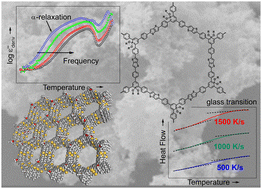Emamverdi, F.; Huang, J.; Szymoniak, P.; Bojdys, M. J.; Böhning, M.; Schönhals, A. Mater. Adv. 2024. DOI: 10.1039/d3ma01123b

Scientists have identified a glass transition in amorphous covalent organic frameworks (COFs), a finding that challenges the conventional understanding of these materials. The research focused on two novel phosphinine-based COFs, distinguished by methoxy (CPSF-MeO) and ethoxy (CPSF-EtO) groups, revealing significant differences in their thermal behavior and structure.
The analysis demonstrated that CPSF-EtO transitions into a glass state at a temperature approximately 100 K higher than CPSF-MeO, attributed to the different ways in which the molecular layers stack and interact. This behavior was confirmed through both calorimetry and dielectric measurements, suggesting that these amorphous COFs exhibit glass-like properties.
This breakthrough opens up new possibilities for the application of COFs in various technologies, including gas storage and separation, by harnessing their unique structural and thermal characteristics.
